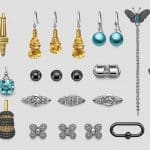Types Of Sunglasses
Sunglasses are an essential accessory for anyone who spends time outdoors. Not only do they protect your eyes from harmful UV rays, but they also help reduce glare and improve visibility. With so many types of sunglasses available, it can be overwhelming to choose the right pair. In this article, we will explore the different types of sunglasses and provide tips on how to choose the best pair for your needs.
Types of Sunglasses by Style
Sunglasses come in a variety of styles, each with its own unique features. Some popular styles include aviators, wayfarers, round, square, and cat-eye. Aviators are a classic style that features large lenses and a thin metal frame. Wayfarers have a thick plastic frame and a square shape. Round sunglasses have circular lenses and a vintage feel, while square sunglasses have a more modern look. Cat-eye sunglasses are a feminine style with upswept frames that resemble a cat’s eyes.
Lens Technology and Features
When choosing sunglasses, it’s important to consider the lens technology and features. Polarized lenses reduce glare and improve visibility, making them ideal for activities such as fishing and boating. Photochromic lenses adjust to changing light conditions, while mirrored lenses reflect light away from the eyes. Anti-reflective coatings reduce glare and improve visual clarity.
Material and Durability
Sunglasses are made from a variety of materials, including plastic, metal, and acetate. Plastic frames are lightweight and durable, while metal frames are strong and long-lasting. Acetate frames are a combination of plastic and metal and offer the best of both worlds. When choosing sunglasses, consider the durability of the frame and the quality of the lenses.
Key Takeaways
- There are many different types of sunglasses available, each with its own unique features and style.
- When choosing sunglasses, it’s important to consider the lens technology and features, as well as the durability of the frame.
- Polarized lenses, photochromic lenses, and anti-reflective coatings are just a few of the features to consider when choosing sunglasses.
Types of Sunglasses by Style

When it comes to sunglasses, there are a variety of styles to choose from. Each style has its unique look and benefits. Here are some of the most popular styles of sunglasses:
Aviator Sunglasses
Aviator sunglasses are a classic style that has been around since the 1930s. They were originally designed for pilots to protect their eyes from the bright sun while flying. Today, aviator sunglasses are a popular style for both men and women. They have a teardrop shape and thin metal frames. Aviator sunglasses are a great choice for people with oval or round face shapes.
Wayfarer Sunglasses
Wayfarer sunglasses are another classic style that has been around since the 1950s. They have a thick plastic frame and a trapezoidal shape. Wayfarer sunglasses are a versatile style that can be worn by both men and women. They are a great choice for people with square or oval face shapes.
Clubmaster Sunglasses
Clubmaster sunglasses are a stylish and sophisticated style that has been around since the 1950s. They have a thick plastic frame on the top and thin metal frames on the bottom. Clubmaster sunglasses are a great choice for people with oval or round face shapes.
Round Sunglasses
Round sunglasses are a retro style that has been around since the 1960s. They have a circular shape and thin metal frames. Round sunglasses are a great choice for people with square or oval face shapes.
Cat-Eye Sunglasses
Cat-eye sunglasses are a feminine and playful style that has been around since the 1950s. They have an upswept shape and thick plastic frames. Cat-eye sunglasses are a great choice for people with oval or heart-shaped face shapes.
When choosing a pair of sunglasses, it is important to consider your face shape and the style of sunglasses that will best complement your features. Whether you prefer aviator, wayfarer, clubmaster, round, or cat-eye sunglasses, there is a style out there for everyone. Additionally, there are many designer sunglasses available that offer a variety of unique styles such as butterfly, oval, and geometric sunglasses for both men and women.
Lens Technology and Features
Polarized Lenses
Polarized lenses are specialized lenses that reduce glare from surfaces such as water, snow, and glass. They work by filtering out horizontal light waves that cause glare, while still allowing vertical light waves to pass through. This makes them ideal for activities such as fishing, boating, and driving, where glare can be a safety hazard. Polarized lenses also enhance visual acuity and color contrast, making them a popular choice for outdoor enthusiasts.
Mirrored Lenses
Mirrored lenses have a reflective coating that reflects light away from the eyes, reducing glare and bright light. They are ideal for bright and sunny conditions, and are often used by athletes and outdoor enthusiasts. Mirrored lenses also provide a stylish and fashionable look.
Photochromic Lenses
Photochromic lenses are lenses that darken in response to UV light, and lighten when UV light is not present. They are ideal for people who spend a lot of time outdoors, as they automatically adjust to changing light conditions. Photochromic lenses are available in a variety of tint colors, and can be used for a variety of outdoor activities.
Gradient Lenses
Gradient lenses are lenses that are darker at the top and lighter at the bottom. They are ideal for driving, as they provide good visibility for the dashboard and road ahead, while still providing protection from the sun. Gradient lenses are also a popular choice for fashion sunglasses, as they provide a stylish look.
In addition to the above lens technologies, there are also other lens features that can enhance the performance of sunglasses. Some of these features include anti-reflective coating, which reduces glare and improves visual acuity, and UV protection, which protects the eyes from harmful UV rays. When choosing sunglasses, it is important to consider the activities they will be used for, as well as the level of protection and performance required.
Material and Durability
When it comes to sunglasses, the material used in the frame and lenses can greatly impact the durability and longevity of the sunglasses. In this section, we will explore the different materials commonly used in sunglasses and their advantages and disadvantages.
Frame Material
The frame material of sunglasses is an important consideration when looking for a durable pair. Some of the most common frame materials include acetate, titanium, and stainless steel.
Acetate frames are lightweight and flexible, making them a popular choice for fashion sunglasses. However, they are not as durable as other materials and can be prone to breaking.
Titanium frames are strong and lightweight, making them a popular choice for sports sunglasses. They are also corrosion-resistant, making them a good choice for those who spend a lot of time near saltwater. However, titanium frames can be more expensive than other materials.
Stainless steel frames are durable and corrosion-resistant, making them a good choice for everyday wear. They are also more affordable than titanium frames. However, they can be heavier than other materials.
Lens Material
The lens material of sunglasses is another important consideration when looking for a durable pair. Some of the most common lens materials include glass lenses, plastic lenses, and polycarbonate lenses.
Glass lenses are scratch-resistant and offer excellent clarity. However, they can be heavy and are more prone to shattering than other materials.
Plastic lenses are lightweight and shatter-resistant, making them a good choice for sports sunglasses. However, they can be prone to scratching.
Polycarbonate lenses are lightweight and impact-resistant, making them a popular choice for sports sunglasses. They are also scratch-resistant and offer good clarity. However, they can be more prone to distortion than other materials.
In conclusion, the frame and lens materials used in sunglasses can greatly impact their durability and longevity. When looking for a pair of sunglasses, it is important to consider the materials used and choose a pair that fits your needs and lifestyle.
Sunglasses for Specific Needs
When it comes to sunglasses, there are many different types available to meet specific needs. Whether you need prescription sunglasses, sports sunglasses, or performance sunglasses, there is a pair out there that will suit your needs perfectly.
Prescription Sunglasses
For those who wear prescription glasses, prescription sunglasses are a must-have. These sunglasses are designed to correct vision while also protecting the eyes from the sun’s harmful rays. Prescription sunglasses are available in a wide range of styles, from classic aviators to sporty wraparounds.
Sports Sunglasses
Sports sunglasses are designed for those who lead an active lifestyle. They are lightweight, durable, and provide excellent eye protection. Sports sunglasses are available in a variety of styles, including wraparound, shield, and half-frame. They are also available with polarized lenses, which reduce glare and improve visibility in bright sunlight.
Performance Sunglasses
Performance sunglasses are designed for athletes who need the best possible eye protection. They are made from high-quality materials and feature lenses that provide excellent sun protection. Performance sunglasses are available in a variety of styles, including wraparound, shield, and half-frame. They are also available with polarized lenses, which reduce glare and improve visibility in bright sunlight.
When choosing sunglasses for specific needs, it is important to consider factors such as eye protection, sun protection, and UVB rays. UVB rays are the most harmful rays from the sun and can cause macular degeneration and cataracts. Look for sunglasses that provide 100% UVB protection to protect your eyes from these harmful rays.
In summary, there are many different types of sunglasses available to meet specific needs. Whether you need prescription sunglasses, sports sunglasses, or performance sunglasses, there is a pair out there that will suit your needs perfectly. It is important to choose sunglasses that provide excellent eye protection, sun protection, and UVB protection to keep your eyes healthy and safe.
Choosing the Right Sunglasses
When it comes to choosing the right sunglasses, there are a few important factors to consider. Whether you’re looking for sunglasses for fashion or function, it’s crucial to find a pair that fits your face shape, provides adequate eye protection, and suits your personal style. Here are some tips to help you choose the right sunglasses.
By Face Shape
The first step in choosing the right sunglasses is to consider your face shape. Different face shapes look best with different styles of sunglasses. For example, heart-shaped faces look great with cat-eye or aviator-style sunglasses, while angular faces look best with round or oval frames. Square and rectangle faces can benefit from softer, curved frames, while round faces can be balanced out with angular, geometric frames.
For Eye Health
Sunglasses are not just a fashion accessory – they also play an important role in protecting your eyes from harmful UV rays. When choosing sunglasses, look for pairs that offer 100% UV protection to help prevent eye strain and photokeratitis (a painful eye condition caused by exposure to UV rays). Some sunglasses also offer protection against blue light, which can cause eye strain and disrupt sleep.
Fashion and Trends
Of course, style is also an important factor to consider when choosing sunglasses. Look for frames that suit your personal style and complement your wardrobe. Keyhole bridges and hypoallergenic materials are also popular features to look for. When shopping for sunglasses, try on several different styles to see which ones look and feel best on you.
Overall, choosing the right sunglasses is all about finding a balance between fashion and function. By considering your face shape, eye health, and personal style, you can find a pair of sunglasses that not only look great but also provide the protection your eyes need.






